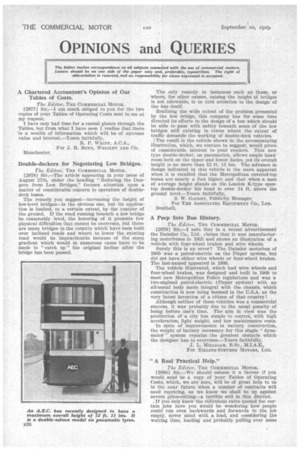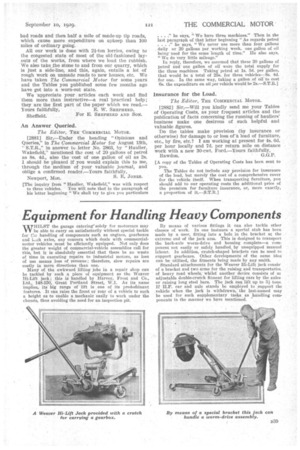OPINIONS and QUERIES The Editor invites correspondence on all subjects
Page 64

Page 65

If you've noticed an error in this article please click here to report it so we can fix it.
connected with the use of commercial motors. Letters should be on one side of the paper only and, preferably, typewritten. The right of abbreviation is reserved, and no responsibility for views expressed is accepted.
A Chartered Accountant's Opinion of Our Tables of Costs.
The Editor, THE COMMERCIAL MOTOR.
[2877] Sir,—I am much obliged to you for the two copies of your Tables of Operating Costs sent to me at my request.
I have only had time for a casual glance through the Tables, but from what I have seen I realize that there is a wealth of information which will be of extreme value and interest.—Yours faithfully, R. P. WHIPP, A.C.A., For J. B. limn, WRIGLEY AND CO.
Manchester.
Double-deckers for Negotiating Low Bridges.
The Editor, THE COMMERCIAL MOTOR.
[28781 Sir,—The article appearing in your issue of August 27th, under the heading "Reducing the Dangers from Low Bridges," focuses attention upon a matter of considerable concern to operators of doubledeck buses.
The remedy you suggest—increasing the height of low-level bridges—is the obvious one, but its application is limited, to a certain extent, by the contour of the ground. If the road running beneath a low bridge be reasonably level, the lowering of it presents few physical difficulties that cannot be overcome, but there are many bridges in the country which have been built over inclined roads and where to lower the existing road would be impracticable because of the steep gradient which would in numerous cases have to be made to "catch up" the original incline after the bridge has been passed. The only remedy in instances such as these, or Where, for other causes, raising the height of bridges is not allowable, is to turn attention to the design of the bus itself.
Realizing the wide extent of the problem presented by the low bridge, this company has for some time directed its efforts to the design of a bus which should be able to pass with safety beneath some of the low bridges still existing in towns where the extent of traffic demands the working of double-deck vehicles.
The result is the vehicle shown in the accompanying illustration, which, we venture to suggest, would prove of considerable interest to your readers. This new type double-decker, on pneumatics, allows ample headroom both on the upper and lower decks, yet its overall height is no more than 12 ft. 11 ins. The advance in design indicated in this vehicle is the more apparent when it is recalled that the Metropolitan covered-top buses are nearly a foot higher and that when a man of average height stands on the London K-type opentop double-decker his head is over 14 ft. above the ground level.—Yours faithfully, S. W. GOODEY, Publicity Manager, For THE ASSOCIATED EQUIPMENT CO., LTD. Southall.
A Peep Into Bus History.
The Editor, THE COMMERCIAL MOTOR.
[2879] Sir,—I note that in a recent advertisement the Daimler Co., Ltd.. claims that it was manufacturing motorbuses in 1905 and shows an illustration of a vehicle with four-wheel brakes and wire wheels.
Surely this is an error? The Daimler motorbus of 1905 was a petrol-electric on the Pieper system, but did not have either wire wheels or four-wheel brakes. The last-named appeared in 1908.
The vehicle illustrated, which had wire wheels and four-wheel brakes, was designed and built in 1909 to meet new Metropolitan Police regulations and was a two-engined petrol-electric (Pieper system) with an all-metal body made integral with the chassis, which construction is now being boomed in the U.S.A. as the very latest invention of a citizen of that country!
Although neither of these vehicles was a commercial success, it was probably due to the usual penalty of being before one's time. The aim in view was the production of a city bus simple to control, with high acceleration, light weight, and low maintenance costs.
In spite of improvements in battery construction, the weight of battery necessary for this single " dynamotor " system repiains the greatest obstacle which the designer has to overcome.—Yours faithfully,
J. L. MILLIGAN, B.Sc. M.I.A.E FOR TILL1NG-STEVENS itIOTORB, LTD.
"A Real 'Practical Help."
The Editor, THE COMMERCIAL MOTOR.
[2880] Sir,--We should esteem it a favour if you would send us a copy of your Tables of Operating Costs, which, we are sure, will be of great help to us in the near future when a number of contracts will need repricing, as we know we shall be up against severe price-cutting—a terrible evil in this district.
If you only knew the ridiculous rates quoted for certain jobs here you would be wondering how people could run even backwards and forwards to the job empty, never mind with a load, and considering the waiting time, loading and probably pulling over some bad roads and them half a mile of made-up tip roads, which cause more expenditure on upkeep than 100 miles of ordinary going.
All our work is done with 21-ton lorries, owing to the congested state of most of the old-fashioned lay outs of the works, from where we load the rubbish.
We also take the stone to and from our quarry, which is just a side-line, and this, again, entails a lot of rough work on unmade roads to new houses, etc. We have taken The Commercial Motor for some years and the Tables you published some few months ago have got into a worn-out state.
We 'appreciate your articles each week and find them more than Instructive—a real 'practical help; they are the first part of the paper which we read.— Yours faithfully, E. W. SHEPHERD, Sheffield. For E. SHEPHERD AND SON.
An Answer Queried.
The Editor, THE COMMERCIAL MOTOR. • [2881] Sir,—Under the heading "Opinions and Queries," in The Commercial Motor for August 13th, " S.T.R.," in answer to letter No. 2863, by " Haulier, Wakefield," mentioned the cost of 20 gallons of petrol as 8s. 4d., also the cost of one gallon of oil as 2s. I should be pleased if you would explain this to me, through the medium of your valuable jouenal, and oblige a confirmed reader.—Yours faithfully, . Newport, Mon. S E. JONES.
[The inquiry from " Haulier, Wakefield," was with respect to three vehicles. You will note that in the paragraph of his letter beginning "We shall try to give you particulars
. . ." he says, "We have three machines." Then in the last paragraph of that letter beginning "As regards petrol
. ." he says "We never use more than four gallons daily or 20 gallons per working week, one gallon of oil being used for the same 'length of time." Lie also says, "We do very little mileage."
In reply, therefore, we assumed that these 20 gallons of petrol and one gallon of oil wete the total supply for the three machines. Taking' petrol at is. 3d. per gallon, that would be a total of 25s. for three vehicles-8s. 4d. for one. In the same way, taking a gallon of oil' to cost ets, the expenditure on oil per vehicle would be 2s.—S.T.R.]
Insurance for the Load.
The Editor, THE COMMERCIAL MOTOR.
[2882] Sir,—Will you kindly send me your Tables of Operating Costs, as your frequent articles and the publication of facts concerning the running of hauliers' business make one desirous of such helpful and valuable .figures. • Do the tables make provision (by insurance or otherwise) for damage to or loss or a load of furniture, etc., by fire, etc.? I am working at present for 4s. lid. per hour locally and 7d. per return mile on distance work with a new 30-cwt. Ford.—Yours faithfully, Rawdon. G.G.P.
[A copy of the Tables of Operating Costs has been sent to you.
The Tables do not include any provision for insurance of the load, but merely the cost of a comprehensive cover for the vehicle itself. When transporting furniture, you should add to our operating costs the additional price of the premium for furniture insurance, or, more exactly, a proportion of it.—S.T.R.]




















































































































